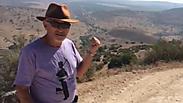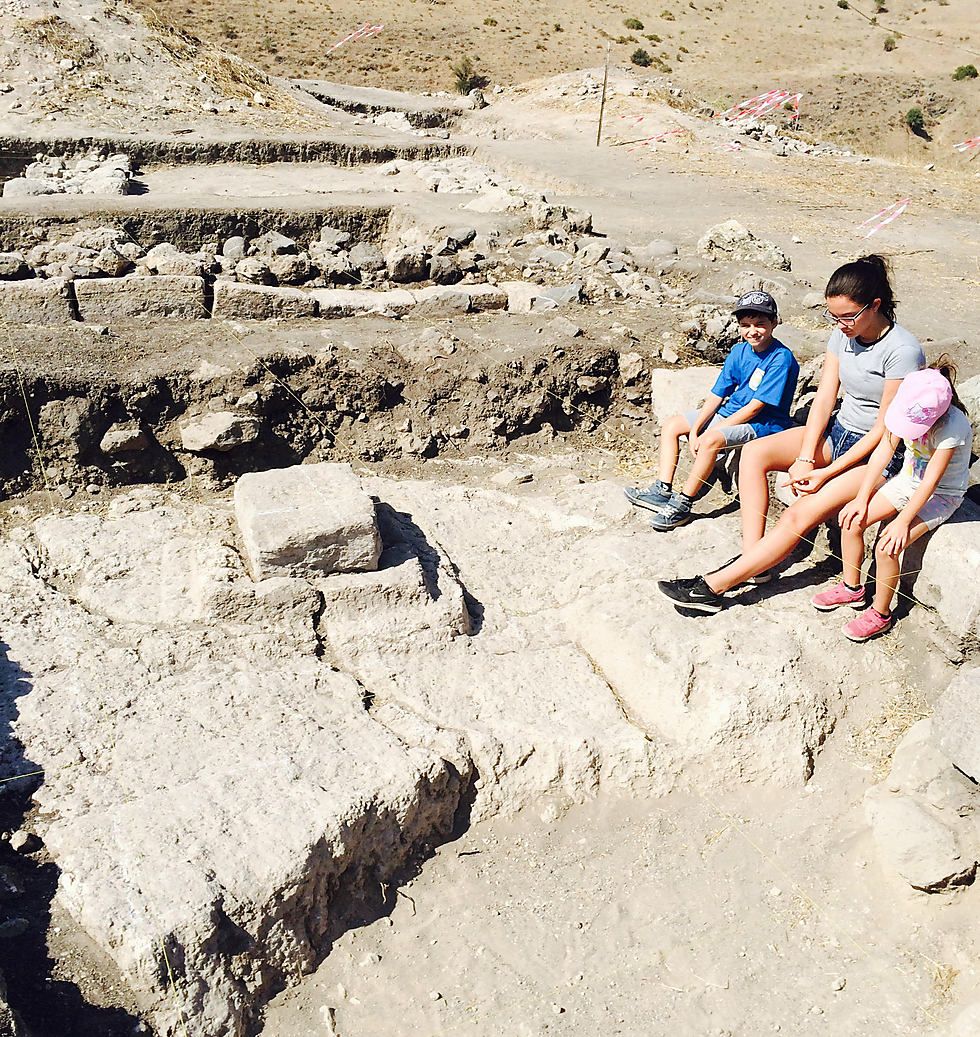
Ancient synagogue discovered in Galilee
Leading up to fast of Tisha B'Av marking destruction of two temples, archaeologists make massive discovery in northern Israel which survived Roman attacks; Expert says find also important for Christians.
Last Tuesday, an excavation team discovered, just ten centimeters below the peak’s surface, a synagogue from the first century AD. The find contained a huge and impressive room nine meters high and eight meters wide with walls lined with benches made of limestone blocks. Diggers also discovered one of the two foundational pillars supporting the synagogue's roof.
The discovery is important not only because it coincides with the three-week mourning period preceding the fast of Tisha B’Av marking the destruction of the First and Second Temples, but because of its significance for the Christian population. The finding also reveals insights into customs of the ancient Jewish community and sheds light on watershed moments in Jewish history.
For six years Dr. Motti Aviam, an expert in archaeology of the Roman period and a senior researcher in the Kinneret Institute for Galilean Archaeology has been conducting digs at the upper areas of Tel Recheš, where an estate once stood during the Roman era.
“This is the first synagogue of its kind in the Galilee villages,” Dr. Aviam explained. “In Migdal, for example, there is a synagogue but that is a big city. Here we are talking about a magnificent agricultural area about four Dunam in size where buildings are decorated with frescoes and stucco articles. Jewish families lived in the estate but due to the fact that the nearest synagogue was four kilometers away (a distance deemed too far from a community according to Jewish law) the owner of the estate built the synagogue for himself and for the dozens of workers in his employment.”
Tel Recheš has been well known to archaeologists since the beginning of the last century. During the British Mandate it was known that most layers of the peak contained artifacts from the Bronze and Iron Ages.
During the last ten years, each summertime a delegation of students has arrived to Israel from universities in Japan, and conducted archeological digs under the directorship of Dr. Yitzhak Paz from the Antiquities Authority and two other university professors.
Dr. Aviam told Ynet that the remains of objects were found which could definitely be dated back to the first century AD. Prior to the recent discovery, archaeologists already suspected the presence of a Jewish community on the peak.
Indeed, one of the main reasons that the researchers were able to extrapolate that the estate belonged to a Jewish community was the absence of pig bones or remains. Indeed, pig was a staple part of a community’s diet in which Jews did not reside.
Further proof that Tel Recheš was an old Jewish community was the existence of many stone utensils. According to Jewish law, stone utensils cannot become impure, unlike other tool such as metal and glass. The preferred material of choice for cooking among Jews toward the end of the Second Temple era was stone.
What proved beyond any doubt as to the Jewish presence on the peak was not only the new discovery of the ancient synagogue, but the very layout of the benches along the structure’s walls. This is the common feature of a Sephardic synagogue’s designed in which worshippers sit along the wall facing the center of the room. It was customary for the the prayer reader to stand in the center of the room and read portions and lessons of the Torah during the Sabbath and the Jewish holidays.
Dr. Aviam added, “This is a simple synagogue but it is not simple to build a synagogue. The benches that we discovered are made of beautiful white Ashlar stone and the large foundational pillars required considerable investment and were expensive.”
Since the failure of the Bar Kokhba revolt to the present day, it is customary that newly built synagogues face the direction of Jerusalem. “It was also not customary to do this in other synagogues from the same era in other areas such as Migdal and Modi’in. In those days synagogues were not used for prayer toward Jerusalem since prayers were only instituted after the the destruction of the Second Temple,” Dr. Aviam explained.
"In all likelihood, only after the second rebellion did they start building synagogues which always contained Torah arks as a consistent feature of the synagogue placed in the wall facing Jerusalem to signify the memory of the temple,” he continued. “During the days of the Second Temple, just like in the days of the First Temple, most religious rituals included sacrifices by the high priests in the Temple. That is why synagogues throughout the world were only used until the destruction to read the Torah and to deliver sermons.”

Rabbinic literature records the destruction of the Temples as Holocausts in which the Romans obliterated the majority of the Jewish population and entire towns.
The situation in the Galilee however differed from those in the Judea region. During the Roman ‘sojourn’ in the Galilee, on orders given by Vespasian and Titus, a number of towns were destroyed. The majority of the population in the Galilee and their villages however, were left predominantly untouched. Tel Recheš was one such estate.
According to the researchers’ assessments, the estate was likely abandoned only because of the second revolt against Rome. “The scientific research indicates that the Bar Kokhba rebellion took place mainly in Judea which is why Judea was destroyed,” said Dr. Aviam. “In practice, there is not a single village in Judea which survived and continued to function after the revolt. Everything was destroyed.”
"In the Galilee, by contrast, no fighting took place. There were Jews who travelled to Judea in order to join the fight whereas in the Galilee sporadic incidents, at most, broke out when the Romans suspected families of stockpiling weapons.”
Dr. Aviam explained how these families would then be investigated and their homes would be destroyed. “The Jewish family which lived in the estate where the synagogue was discovered simply abandoned the place for reasons which are not clear to us and that is essentially what enabled it to survive,” he said.
According to Dr. Aviam the find also marks an important milestone for the Christian world. “The New Testament describes how Jesus delivered sermons in a synagogue in Capernaum and other synagogues in the Galilee,” he explained.
“During the same period Jesus was still a Jew who observed Jewish rituals and requirements and like many rabbis, he delivered sermons in synagogues. Christianity which developed after his placed an emphasis on his sermons at synagogues in the Galilee. This makes the place very important for Christians.
“Today there is no easy access to the place,” he concluded. “But I hope that when the work is completed the place will constitute a tourist attraction for Jews and Christians alike.”











